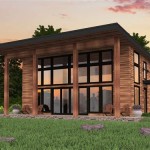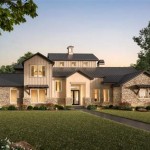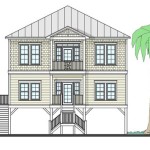Modern Beach House Plans: Designing Your Coastal Dream Home
Designing a modern beach house requires a careful blend of aesthetics, functionality, and resilience. These homes are not just about capturing stunning ocean views; they must also withstand the harsh coastal environment while providing a comfortable and stylish living space. Modern beach house plans prioritize open layouts, natural light, durable materials, and a seamless connection between indoor and outdoor living.
The process of creating such a home involves understanding the specific site conditions, local building codes, and the client’s individual needs and preferences. Architects and designers work collaboratively to translate these elements into a cohesive and innovative design that maximizes the potential of the coastal location.
The allure of modern beach house designs lies in their ability to create a sense of tranquility and connection with nature. By incorporating sustainable practices and innovative building techniques, these homes can be both beautiful and environmentally responsible. Successfully designing these structures requires understanding several key aspects of the design process.
Embracing Open Floor Plans and Natural Light
One of the defining characteristics of modern beach house plans is the emphasis on open floor plans. These designs eliminate interior walls to create a sense of spaciousness and allow for unobstructed views of the ocean or surrounding landscape. Open layouts also promote better airflow, which is particularly important in humid coastal climates. The integration of living, dining, and kitchen areas fosters a sense of connection and encourages social interaction.
Maximizing natural light is another crucial element. Large windows, sliding glass doors, and skylights are strategically placed to flood the interior with sunlight. This not only reduces the need for artificial lighting but also enhances the feeling of well-being and connection with the outdoors. The use of light-colored interior finishes and reflective surfaces helps to further amplify the natural light, creating a bright and airy atmosphere.
Orientation of the house on the lot is also essential for optimizing natural light and ventilation. Ideally, the primary living spaces should face south or east to capture the morning sun and minimize the intensity of the afternoon heat. Overhangs and shading devices can be incorporated to provide protection from direct sunlight and prevent overheating during the hottest parts of the day.
Careful consideration must be given to the placement of windows and doors to facilitate cross-ventilation. This allows for natural airflow throughout the house, reducing the reliance on air conditioning. Operable windows and doors in strategic locations can create a comfortable and energy-efficient living environment. The design should also account for prevailing winds and incorporate features that channel and direct airflow.
Ultimately, the goal is to create a living space that feels both connected to the natural environment and comfortable for daily life. The open floor plan and abundant natural light contribute to a sense of spaciousness, tranquility, and well-being, making the beach house a true retreat.
Selecting Durable and Sustainable Materials
Choosing the right materials is critical when designing a modern beach house. The coastal environment presents unique challenges, including saltwater exposure, high winds, and intense sunlight. Materials must be durable, weather-resistant, and able to withstand the harsh conditions without deteriorating or requiring excessive maintenance. Furthermore, sustainable materials are often prioritized to minimize the environmental impact of the construction process.
For exterior cladding, options such as fiber cement siding, cedar shingles, and stucco are popular choices. Fiber cement siding is resistant to rot, insects, and fire, making it a durable and low-maintenance option. Cedar shingles offer a natural and aesthetically pleasing look while providing excellent weather resistance. Stucco is a traditional choice that can be customized with various textures and colors.
Window and door frames should be made of materials that are resistant to corrosion and moisture damage. Aluminum, fiberglass, and vinyl are common choices for coastal environments. Insulated glass units (IGUs) are essential for energy efficiency and can help to reduce heat gain and loss. Low-E coatings can further enhance the performance of windows and doors by blocking UV radiation and reducing glare.
For decking and outdoor living spaces, durable and weather-resistant materials are essential. Composite decking, made from recycled plastic and wood fibers, is an excellent alternative to traditional wood decking. It is resistant to rot, insects, and fading, and requires minimal maintenance. Tropical hardwoods, such as Ipe and Teak, are also popular choices due to their natural durability and resistance to decay.
Inside the house, flooring materials should be chosen for their durability and ease of maintenance. Tile, concrete, and engineered wood are all suitable options for beach houses. Tile is water-resistant and easy to clean, making it ideal for bathrooms and kitchens. Concrete can be stained, polished, and sealed to create a durable and stylish surface. Engineered wood is more resistant to moisture and warping than solid hardwood, making it a better choice for coastal environments.
Sustainable material choices can include recycled content materials, rapidly renewable resources, and locally sourced materials. Using materials with a low environmental impact reduces the overall carbon footprint of the construction process.
Creating Seamless Indoor-Outdoor Living Spaces
One of the most appealing aspects of modern beach house design is the seamless integration of indoor and outdoor living spaces. This connection allows residents to fully enjoy the beauty and tranquility of the coastal environment. Designing these spaces requires careful consideration of the layout, materials, and features that facilitate a smooth transition between the interior and exterior.
Large sliding glass doors or bi-fold doors are often used to create a wide opening between the living room and an outdoor deck or patio. These doors allow for unobstructed views and easy access to the outdoor space. When fully opened, they create a sense of continuity between the interior and exterior, blurring the boundaries between the two.
Outdoor living areas should be designed as extensions of the interior living space. Comfortable seating, dining areas, and outdoor kitchens can be incorporated to create a functional and inviting space for relaxation and entertainment. The use of outdoor rugs, cushions, and accessories can add a touch of style and comfort to the outdoor space.
Shading devices, such as pergolas, awnings, and shade sails, can provide protection from the sun and create a more comfortable outdoor environment. These features can also add architectural interest to the house and enhance its overall aesthetic appeal. Landscaping plays a crucial role in creating a seamless transition between the interior and exterior. Native plants and drought-tolerant species should be used to create a natural and sustainable landscape. Trees and shrubs can provide shade, privacy, and wind protection. Water features, such as fountains or ponds, can add a sense of tranquility to the outdoor space.
Outdoor lighting is essential for creating a welcoming and functional outdoor space at night. Path lighting, accent lighting, and task lighting can be used to illuminate walkways, highlight architectural features, and provide adequate lighting for outdoor activities. Energy-efficient LED lighting is a good choice for outdoor lighting due to its long lifespan and low energy consumption.
The design should also consider the practical aspects of outdoor living, such as storage for outdoor furniture, equipment, and recreational gear. Outdoor showers are a popular addition to beach houses, providing a convenient way to rinse off after swimming or surfing. Integrating these elements effectively can significantly enhance the functionality and enjoyment of the beach house.
Ultimately, the goal is to create an outdoor living space that is seamlessly integrated with the interior, providing a comfortable and inviting environment for relaxation, entertainment, and connection with nature. The thoughtful design of these spaces enhances the overall value and appeal of the modern beach house.
Modern beach house plans are complex projects requiring collaboration among architects, designers, and builders. However, the end result can be a beautiful, functional, and sustainable home that offers its occupants a unique and rewarding coastal living experience. By focusing on innovative design principles, durable materials, and seamless indoor-outdoor connections, these homes can truly capture the essence of the coastal lifestyle.

Build A Home On The Beach House Plans Blog Dreamhomesource Com

Build A Home On The Beach House Plans Blog Dreamhomesource Com

Beach Style House Plan 4 Beds 3 5 Baths 2894 Sq Ft 938 126 Houseplans Com

California Coastal Farmhouse Beach House Home Bunch Interior Design Ideas
Build A Home On The Beach House Plans Blog Dreamhomesource Com

West Indies Caribbean Style Home Plans Sater Design Collection

Build A Home On The Beach House Plans Blog Dreamhomesource Com

West Indies Caribbean Style Home Plans Sater Design Collection

Build A Home On The Beach House Plans Blog Dreamhomesource Com

Beautiful Beach House Plans Blog Eplans Com
Related Posts








